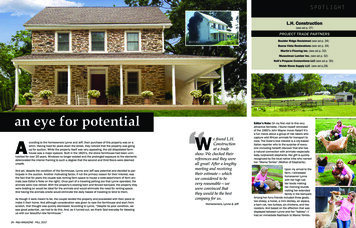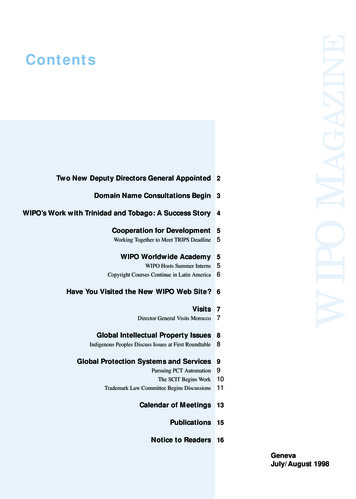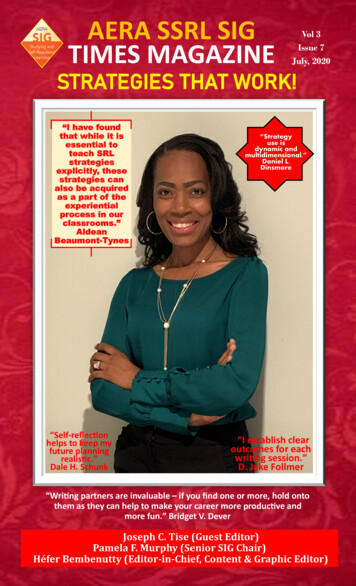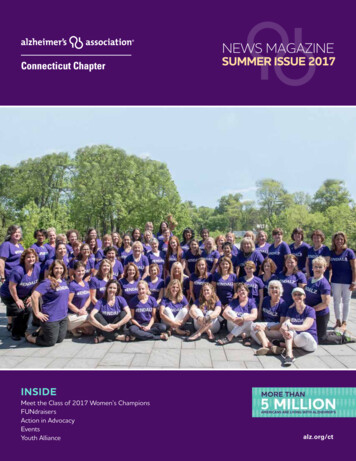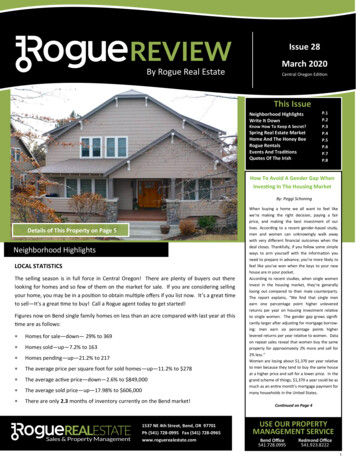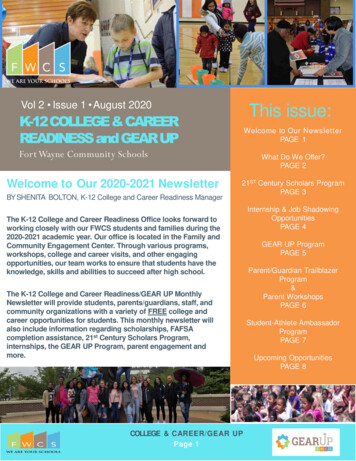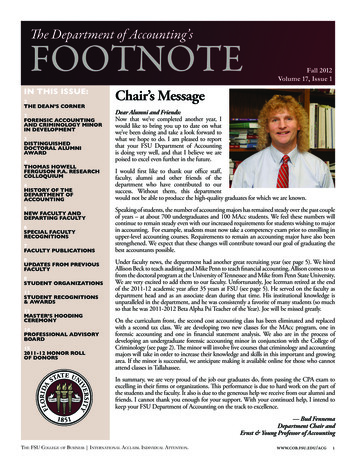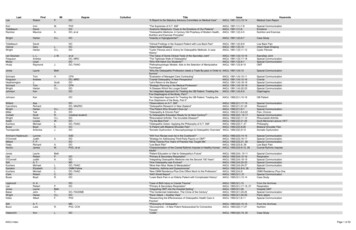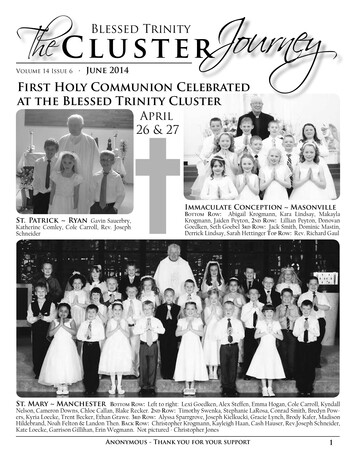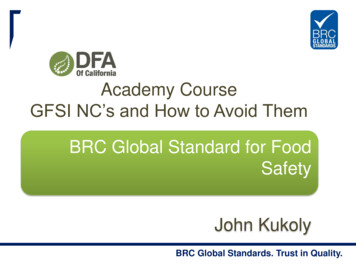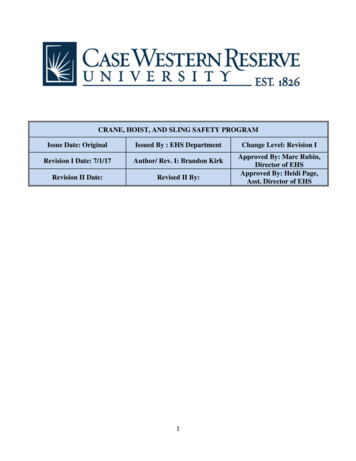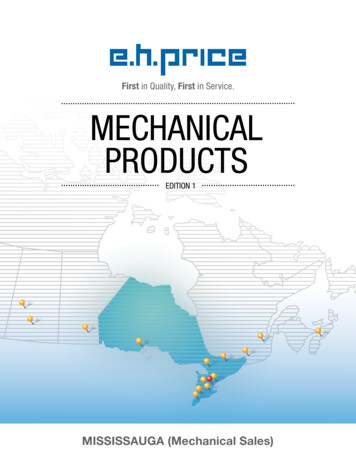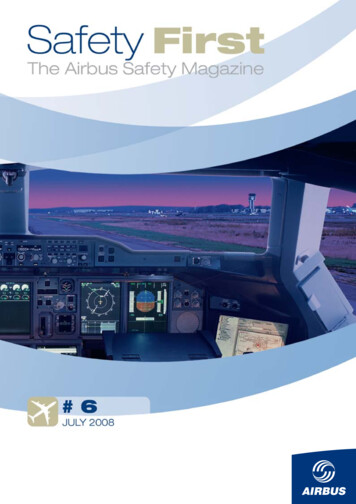
Transcription
Editorial# 06 July 2008Yannick MALINGEVice PresidentFlight SafetyContentDear Customers and Aviation Safety colleagues,The Airbus Safety Magazine . . . . . . . . . . . . . . . . .Runway excursions remain one of the three main accidentcategories, accounting for about a quarter of all accidentsin 2007.NewsThe following two main contributing factors to these eventshave been well identified in the past by the aviationcommunity : Unstabilized approaches Lack of go-around decisionAs announced in the previous issue of this magazine, the“A320/ Runway overrun” article that you will find hereafterillustrates very well the need to repeat the lessons learntfrom these occurrences. This is particularly true for thenew entrants in the aviation community.On a different subject, we are very pleased to publish thearticle titled “FCTL check after EFCS reset on ground”,as it has been co-written by an Airbus operator.Let me take this opportunity to remind you that weencourage our customer to share safety information thatcould bring added value to other Airbus operators, byproviding airline safety articles for this magazine.Information . . . . . . . . . . . . . . . . . . . . . . . . . . . . . . . . . . . . . . . . . . .A320/ Runway overrunM. BaillionFCTL check after EFCSreset on groundK. Tritschler & A. Urdiroz.A320/ Possible consequencesof VMO/MMO exceedanceM. Palomèque.A320/ Prevention of tailstrikesM. Palomèque.Low fuel situations awarenessF. Marani.Rudder pedal JamJ. RenduI hope you will enjoy reading this sixth issue of SafetyFirst, and look forward to meet you at the 15th Flight SafetyConference in Paris.Why do certain AMM tasks requireequipment resets?D. Harris . . . . . . . . . . . . . . . . . . . . . . . . . . . . . . . . . . . . . . . . . . . . . . . .Slide/Raft ImprovementYours sincerelyF. SauvageYannick MALINGEVice President Flight Safety.Cabin attendant falling throughthe avionics bay access panel in cockpitP-O. Guenzel.12341014182227293133
Safety First1# 06 July 2008The Airbus Safety MagazineSafety FirstThe Airbus Safety MagazineFor the enhancement of safe flight throughincreased knowledge and communications.Safety First is published by the Flight Safety Departmentof Airbus. It is a source of specialist safety informationfor the restricted use of flight and ground crew memberswho fly and maintain Airbus aircraft. It is also distributedto other selected organisations.requirements or technical orders. The contents do notsupersede any requirements mandated by the State ofRegistry of the Operator’s aircraft or supersede or amendany Airbus type-specific AFM, AMM, FCOM, MELdocumentation or any other approved documentation.Material for publication is obtained from multiple sourcesand includes selected information from the Airbus FlightSafety Confidential Reporting System, incident andaccident investigation reports, system tests and flighttests. Material is also obtained from sources within theairline industry, studies and reports from governmentagencies and other aviation sources.Articles may be reprinted without permission, except wherecopyright source is indicated, but with acknowledgementto Airbus. Where Airbus is not the author, the contents ofthe article do not necessarily reflect the views of Airbus,neither do they indicate Company policy.All articles in Safety First are presented for informationonly and are not intended to replace ICAO guidelines,standards or recommended practices, operator-mandatedContributions, comment and feedback are welcome. Fortechnical reasons the editors may be required to make editorialchanges to manuscripts, however every effort will be madeto preserve the intended meaning of the original. Enquiriesrelated to this publication should be addressed to:AirbusFlight Safety Department (GSE)1, rond point Maurice Bellonte31707 Blagnac Cedex - FranceContact: Marie-Josée EscoubasE-mail: marie-josee.escoubas@airbus.comFax: 33 (0)5 61 93 44 29Safety First# 06 July 2008Safety First is publishedby Airbus S.A.S1, rond point Maurice Bellonte31707 Blagnac Cedex / FranceEditor:Yannick Malinge,Vice President Flight SafetyConcept Design byMUTI MEDIA SUPPORT 20080635Computer Graphic by Quat’coul Airbus S.A.S. 2008 – All rights reserved. Confidential and proprietary documents.By taking delivery of this Brochure (hereafter “Brochure”), you accept on behalf of yourcompany to comply with the following guidelines: No other intellectual property rights are granted by the delivery of this Brochure than theright to read it, for the sole purpose of information. This Brochure and its content shall not be modified and its illustrations and photos shallnot be reproduced without prior written consent of Airbus.Copyright: GSE 420 0279/08 This Brochure and the materials it contains shall not, in whole or in part, be sold,rented, or licensed to any third party subject to payment.Photos copyright AirbusPhotos byExM: Hervé Berenger, PhilippeMasclet, Hervé Goussé.Photo copyright GermanwingsThis Brochure contains sensitive information that is correct at the time of going to press.This information involves a number of factors that could change over time, effecting thetrue public representation. Airbus assumes no obligation to update any information containedin this document or with respect to the information described herein.Computer rendering by ABACPrinted in France by GWLNSDAirbus SAS shall assume no liability for any damage in connection with the use of thisBrochure and of the materials it contains, even if Airbus SAS has been advised of thelikelihood of such damages.
2News15th Flight SafetyConferenceThe planning for this year’s conference is wellunderway. It will be held from the 20th to the 23rdof October in Paris. A provisional agenda has beendefined and the invitations have been sent out inJune. If you are an Airbus customer, and have notyet received an invitation, please contact NuriaSoler at the address below. Please note that thisis a conference for Airbus and our customers only.We do not accept outside parties into theconference so as to ensure that we can have anopen forum for everybody to share information.As always we welcome presentations from you.The conference is a forum for everybody to shareinformation, so if you have something you believewill benefit other operators and/or Airbus, thenplease contact us.We look forward to meeting you all at the conference !Contact: Mrs Nuria SolerE-mail: nuria.soler@airbus.comfax: 33 (0) 561934429
Safety First3# 06 July 2008The Airbus Safety MagazineInformationMagazine distributionIf you wish to subscribe to Safety First, please fillout the subscription form that you will find at theend of this issue.Please note that the paper copies will only beforwarded to professional addresses.Your articlesThis magazine is a tool to help share information,therefore we rely on your inputs. We are keen toreceive articles from customers, that we can passalong to other operators through the magazine.If you wish to share your experience, please contactus.Contact: Marie-Josée Escoubasmarie-josee.escoubas@airbus.comFax: 33 (0) 5 61 93 44 29Safety Informationon the Airbus websitesOn the different Airbus websites we are buildingup more and more safety relevant information foryou to use.The present and previous issues of Safety Firstcan be accessed to in the Flight OperationsCommunity- Safety and Operational Materialschapter-, in the secure area ofwww.airbusworld.comOr directly at the secure site at:https://w3.airbus.com/If you do not yet have access rights, then contactyour IT administrator or refer to “Registrationinformation” (top left of web page).Other safety and operational expertise publications,like the Flight Operation Briefing Notes (FOBN),Getting to Grips with brochures, e-briefings etc are regularly released as well in the Flight OperationsCommunity at the above sites.The FOBN, referred to in some articles in this issue,may as well be found on the Safety Library roomof the general public Airbus website athttp://www.airbus.com/en/corporate/ethics/safety lib/Flight SafetyHotline: 33 (0)6 29 80 86 66E-mail:account.safety@airbus.com
4A320/Runway overrunBy: Marc BAILLIONFlight Safety Director1 IntroductionIt stopped approximately 200 meters beyond therunway limit and the 156 occupants were able toevacuate the plane safely. There was no postimpact fire, but the aircraft suffered a hull loss.The following sequence of events has been retrievedfrom the DFDR and CVR. Data from the latter isincomplete as the Captain’s voice was not audible.Flight conditions at 4 700ft :Runway excursions, together with Controlled FlightInto Terrain (CFIT), are one of the main categoriesof incidents and accidents. In the last two years,ten runway excursions were reported to Airbus.This article will describe on of these occurrences,where the aircraft was damaged beyond economical repairThe root causes of this event are common to manyother runway excursions, and it is thereforeworthwhile to share the lessons learned from thisaccident and to repeat the following key safetymessages: Fly stabilized approaches Be go-around minded2 Descriptionof the eventAn A320 performed a visual approach to arunway 12. The aircraft landed at 6h23’ local timeand overran the end of the 1966 meter long runwayat a speed of approximately 85kt.The aircraft was performing a visual approach.Gross weight was 64t (Max landing weight is 64.5t)Configuration clean (Slat 0 / Flaps 0 ) with landinggears up and locked.Autopilot 1 was engaged in DES (longitudinal mode)and NAV (lateral mode). Both Flight Directors (FD)were engaged. ATHR was engaged in thrust mode.Captain was the Pilot Flying (PF).Selected altitude on FCU was 3 000ft.Aircraft heading was 155 .Wind speed was 23kt, and wind direction 300 .This resulted in a 20kt tailwind and a 13kt rightcrosswind.Speed target was managed by the FMGC andwas equal to 285kt.CAS was 306ktVapp 138kt
Safety First5# 06 July 2008The Airbus Safety MagazineApproachApproaching 3 000ft, The crew contacted ATC :- F/O : “ approaching 10 DME 3 000”- ATC : Roger and wind is calm.Report finals runway 12”.- F/O : “Check finals runway 12 ”.As the aircraft approached 3 000ft, the A/P verticalmode changed to Altitude Acquire (ALT*) then toAltitude Hold (ALT). The ATHR changed to speedmode.The A/P vertical mode was then changed to FlightPath Angle (FPA), with a selected –3 FPA target.The aircraft descended accordingly.The selected FPA was then changed to 0 and theaircraft leveled off at 2 800ft RA.The crew selected configuration 11 and, 3 secondslater, landing gears down.Slats and flaps surfaces reached the position FULLabout 3s after the crew selected this configuration. Speedbrakes started to retract (speedbrakesare inhibited in configuration FULL on A320).The crew armed the ground spoilers, and theselected FPA was successively changed to –3.6 ,then to –5.5 and –7 after having selectedconfiguration 22 at about 2 600ft RA (CAS was198kt ; VFE 200kt).A Single Chime (SC) sounded, which correspondsto the “SPD BRK DISAGREE” caution, triggeredbecause of the difference between the actualposition of the speedbrakes (retracted) versus thecommanded position (extended).The F/O announced “Still high” and immediatelyafter “Too close”.The speedbrake lever remained in the extendedposition until the end of recorded data.The ground spoilers were not rearmed.At 2 300ft RA, the Captain disconnected the A/Pand disengaged both FD.ATC announced “Wind is calm3, cleared to landrunway 12”.At 1 600ft RA, configuration 3 was selected (CASwas 186kt; VFE 185kt).4At about 1 150ft RA, during the LH turn to interceptthe runway centerline, configuration FULL5 wasselected (CAS was 170kt; VFE 177kt) and withinabout one second, speedbrake lever was pushedaft to command extension. To do that, the crewdisarmed the ground spoilers.The F/O announced “High speed he” andimmediately after “Let’s circle again it’s too high”followed by “High”.Configuration 1: Slats 18 / Flaps 0 Configuration 2: Slats 22 / Flaps 15 3The wind information was not reliable because the windindication system had been out of order for several months.A NOTAM had been issued, but the crew was not aware.12The Captain then pushed the stick and increasedthe rate of descent up to 1 900ft/min.At 600ft RA the EGPWS alarm “Sink Rate” triggeredand sounded twice.The Captain decreased the nose-down pitch from–6.5 to –2.5 . The aircraft rate of descent decreased.At 500ft RA CAS was approximately 170kt(Vapp 32), and the rate of descent was about1 800ft/min.F/O said “Our speed is too high. We can makeanother circuit. How about that”.The Captain continued the approach.
6Both brake pedals were kept pressed while Autobrakemode selection was changed to MAX.This had no effect because the Autobrake was notactivated.LandingAt 200ft RA the wind characteristics were: 11kttailwind and 6kt crosswind from the left.At 170ft RA, Autobrake MED was selected.At about 150ft RA, the EGPWS alarm “Sink Rate”triggered and sounded twice.The Captain pulled the stick and adjusted the pitchfrom –2.5 nose down to 1 nose up (reached atabout 50ft). The aircraft rate of descent decreased.At approximately 50ft RA, both thrust levers wereretarded to idle. CAS was 159kt (Vapp 21).The aircraft flew over the runway 12 threshold, ata height of 35ft.F/O called out “Speed”.The aircraft floated above the runway during 9sand both main landing gears touched down atabout 740m beyond the runway 12 threshold (1226m of runway left), CAS was 150kt (Vapp 12).The aircraft bounced and touched down again at1 070m beyond the runway threshold (896m ofr
This magazine is a tool to help share information, therefore we rely on your inputs. We are keen to receive articles from customers, that we can pass along to other operators through the magazine. If you wish to share your experience, please contact us. Contact: Marie-Josée Escoubas marie-josee.escoubas@airbus.com Fax: 33 (0) 5 61 93 44 29 Safety Information on the Airbus websites On
